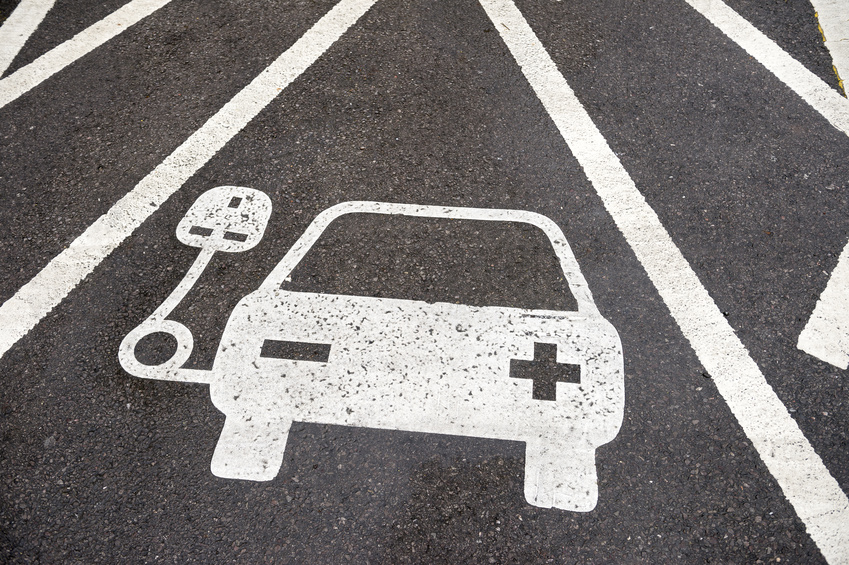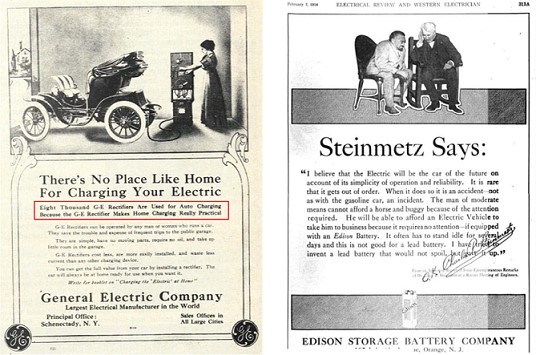
Last week I attended a workshop, “Powering A More Electric Economy”, sponsored by the Wisconsin Public Utility Institute (WPUI). They provide great content, and this workshop was no exception. It got me thinking, which can be dangerous for our staff and Rant readers, but that’s the price you pay to be a daredevil. The primary technologies discussed included electric vehicles (EVs) and heat pumps. In this post, I write about the “what ifs” of potential widespread EV adoption.
The Wheel, Reinvented
Here is something to dazzle your friends, family, and pets with: EVs were popular 100 years ago. I love vintage print ads, so check out the ones provided by a gentleman form Argonne labs:

- Eight thousand G-E rectifiers are used for auto charging because the G-E rectifier makes home charging really practical.
- I believe that the Electric [vehicle] will be the car of the future on account of its simplicity of operations and reliability… The man of moderate means cannot afford a horse and buggy because of the attention required.
Apparently, “electrics” lost the battle with the internal combustion (IC) engine. The IC engine, which powers cars known as internal combustion engine vehicles, or ICEVs, won.
By the way, isn’t the ICEV a terrible acronym, as if there were any good acronyms? I was thinking, is this some new EV?
At this point, I’m reminded of my post regarding Trump, Paris, and the Bumbling Abominable Snow Monster. The market, and only the market, not government Force Majeure, is going to diminish climate change risk. For years I have considered EVs to be a frivolous novelty, but if the populace wants it, someone will deliver, baggage included.
Natural Gas Prices – A Substantial Risk
Consider fuel costs. Natural gas prices, inflation-adjusted, are the lowest they have been in my 20-plus year career in energy efficiency. Nature abhors a vacuum, as they say, and that vacuum is a big one between the price of natural gas and petroleum. The vacuum is also huge between the price of natural gas from U.S. pipelines and natural gas prices in Europe and Asia Pacific.
Rushing to fill the vacuum are hundreds of new petrochemical projects in the U.S., gobbling up cheap natural gas to produce everything from fertilizer to plastics. Also rushing to fill the gaps are liquefied natural gas export and import terminals. And of course, natural gas is filling the gap by displacing coal for generation of zillions of gigawatt hours.
As of last fall, gas exports rose by 50% in six years, and for the first time in 60 years, natural gas exports exceeded imports. Big oil has invested $700 billion in gas projects all over the globe. The upshot is natural gas is now a global fuel with prices set on the world market, like petroleum.
Since natural gas is the major fuel for electricity, the global market for natural gas will push up electricity costs.
Moving back to EVs, rising prices for natural gas is going to increase electricity costs and increase the cost of fueling EVs. Of course, renewables will also provide some of the electrons to fuel EVs, but renewables differ. In California, renewables largely disappear at night as the sun sets. In the great plains, renewable generation increases at night, on average, when the wind speed is higher.
Charging – Where, When, How?
Options become charging with extreme charging[1] stations during the middle of the day (California). At the WPUI workshop, I learned 400-plus kW wireless charging technology already exists. This makes it possible to develop multi-megawatt supercharging stations with many slots, like a fuel oasis. Extreme chargers charge at a rate of 700 miles of range per hour of charging. The gas pump is still about ten times that rate, but 700 mph beats the heck out of about 20 miles per hour of charging at your home, where incidentally, as the ad notes above, people still want to charge their EVs.
It is interesting how fast the tables turn. Recently, I was thinking Californians will be charging their cars at night with electricity produced by natural gas. What is the point? Why not just burn natural gas for car fuel? The same objectives are achieved: greatly reduced local emissions that result in smog and ground-level ozone. Plus, drive range anxiety is diminished (I also learned at WPUI that EV owners are obsessed with topping off their batteries to minimize range anxiety).
Or EV supercharging stations could soak up a lot of daytime solar generation, but that takes some commitment. Fast chargers have to be fast enough to make it worth the wait, like 10 minutes or less, or they are a hassle to use. Customers will pay for these chargers by the precious minute, not kWh. Is that not interesting? In today’s experimental times, a lot of public charging is free. This, of course, will not stand.
The only thing that is certain is behind the scenes, stuff is going to get incredibly complex:
- Demand charges
- Time of use pricing
- Energy storage
- Primary fuel prices
- Variable, and in some places wildly unpredictable, renewable generation (wind)
How does this all get priced to the consumer? Consumers think LED bulb characteristics are complicated? What will they think about miles per kWh? By the way, the mpg equivalent for electric cars is, uh, dumb.
[1] Not to be confused with Tesla’s wimpy 140 kW supercharging station.






